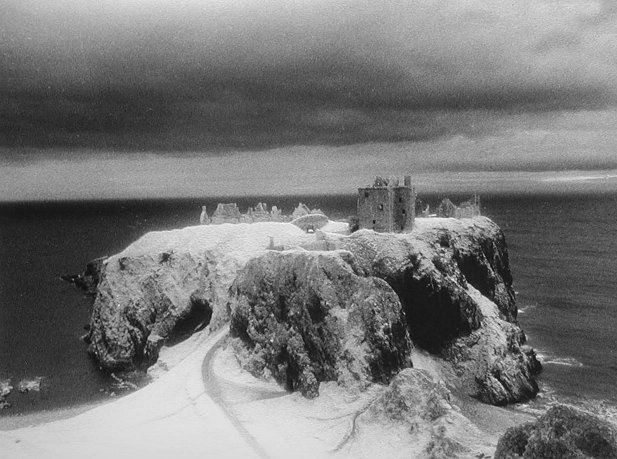"To him who is familiar with history, Dunnottar speaks with an
audible voice," wrote Beattie in Caledonia, "Every cave has a record,
every turret has a tongue...". The name of the castle is derived from the
Old Scot words Dun O Tir which means "Fort in the Highland Low
Country."
The ancient Picts had a prehistoric fort on this rock, and in
the fifth century St. Ninian built a church within its grounds. In the
year 681, the Annals of Ulster mention a siege of the castle and in the
year 900 King Donald II fell in battle against the Vikings at Dunnottar.
In the year 934, it is recorded that King Aethelstan of Wessex
"wasted Scotland with a land army as far as Dunnottar." At the
beginning of the 13th century, the castle figures as a scene of mystical
events in the old French Romance of Fergus and in May of 1276 a parish
church was again consecrated on the rock by the Bishop of St. Andrews.
The castle figured prominently in the Scottish struggle against
English domination and was held by the English in 1297. The castle fell
to the Scottish freedom hordes of Wallace, who burned the English alive when
they took refuge inside the church. In 1336 the English again seized the
castle, and King Edward III visited in July of that year. Shortly
afterwards, the Scottish Regent, Sir Andrew Moray, retook the castle
and burned it.
At the end of the 14th century, the castle was rebuilt by Sir William
Keith, Great Marischal of Scotland and by 1531 a Privy Seal declared
Dunnottar "is ane of the principall strenthis of our realme." In 1595,
some of the victims of a huge witch hunting campaign in nearby
Aberdeen were burned at the stake on Dunnottar.
In 1652 this castle was the only one in Royalist hands, and the
crown, scepter and other Regalia of Scotland were kept there for
safekeeping. The castle fell after eight months of siege to Oliver
Cromwell's armies, but not before the Regalia and papers were taken
out of the fortress under the petticoats of Anne Lindsay of Edzell.
Because of Dunnottar's support for the Jacobite rebellion, the castle was
dismantled in 1715. It stands on a rock promontory 160 feet above the
North Sea and was used in the 1992 Mel Gibson film "Hamlet."
This photograph has won numerous awards in exhibitions in the
United States, Scotland and Mexico. It has been out of print since 1996.





